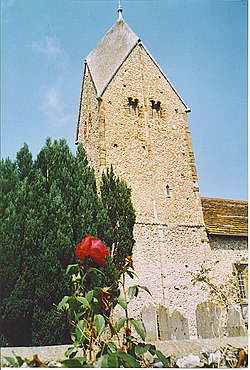Sompting
| Sompting | |
| Sussex | |
|---|---|
 Tower of St Mary's, Sompting | |
| Location | |
| Grid reference: | TQ170047 |
| Location: | 50°49’49"N, 0°20’22"W |
| Data | |
| Population: | 8,561 (2011) |
| Post town: | Lancing |
| Postcode: | BN15 |
| Dialling code: | 01903 |
| Local Government | |
| Council: | Adur |
| Parliamentary constituency: |
East Worthing and Shoreham |
| Website: | http://www.sompting.org.uk/ |
Sompting is a village in the very south of Sussex, sitting on the coast between Lancing and Worthing. It is half grassland slopes and half developed plain at the foot of the South Downs. Twentieth-century estates dovetail into those of slightly larger Lancing.
Contents
Name
The village's name comes from the Old English language, possibly words for "(settlement of) the dwellers at the marsh".[1] Its earliest recorded form is Suntinga, in a document of 956, but Domesday Book (1086) renders the name as Sultinges.
The toponymist Adrian Room has noted, there is no obviously marshy land there nowadays, but it is low-lying and near the sea.[2]
Parish church
The parish church the Church of St Mary the Blessed Virgin, is an Anglo-Saxon and Norman church, separated from the centre of the village since 1939 by the busy A27 road. The church is a Grade I listed building.[3]
The tower of the church is topped with a "Rhenish helm"—a four-sided gabled pyramidal cap which is unique in Britain.[3] The church was originally built in the Anglo-Saxon age, around 960, then was adapted by the Normans when William de Braose, 1st Lord of Bramber granted it to the Knights Templar in the 12th century.[4] The church passed to the Knights Hospitaller in the 15th century when the Templars were suppressed.
About the village
The Sompting Abbotts building, designed by Philip Charles Hardwick and completed in 1856, is a preparatory school.[5] However this has been the site of one of Sompting's manor houses since Norman times, when it was owned by the abbot of Fécamp in Normandy, and later owned by the abbot of Syon Abbey in Middlesex. In 1248 the abbot of Fécamp had a prison in the village.
Queen Caroline, consort of the future King George IV, stayed at Sompting Abbotts in 1814 on her way across the English Channel to Europe.
The old Sompting Rectory building, now used as a nursing home, dates from 1791, however the Rectory has a long history, having previously been owned by the Knights Templar from 1154 and like Sompting Church, passed to the Knights Hospitaller in the 15th century. During the First World War a prisoner-of-war camp was built on the Rectory Farm estate, on the west side of Busticle Lane.
Sompting's Parish Hall was originally built as a reading room in 1889 by HP Crofts of Sompting Abbotts manor: his Crofts/Tristram family have owned farmland and built property in the parish, known as the Sompting Estate, since 1748. As well as the church mentioned alternative Christian worship at the Methodist mission chapel, registered in 1887 formerly took place. Sompting Community Centre was originally built in 1872 as a Junior and Infants School. It was known as a place of innovative education due to the work of the headmistress Harriet Finlay-Johnson who used drama as the focus of the village children's education.[6]
A house which belonged to Edward Trelawny, adventurer, author and friend of Percy Bysshe Shelley, is also in the village.
On the northern edge a settlement existed at Park Brow on the Downs' crest in the Bronze Age through the Iron Age until Roman]] times. It lasted until its buildings were burned down around 270 AD. It is supposed that the inhabitants moved from here to the relative safety of the hillfort at Cissbury Ring.
In the western part of the parish is the Sompting Gap, a protected area that lies between Sompting and Worthing. This area was formerly an inlet of the sea and it is here that the Broadwater Brook (also known as Sompting Brook) flows into Brooklands Park and on into the sea. Some of the reedbeds in the Sompting Gap at Lower Cokeham have been designated a Site of Nature Conservation Importance.
In literature
The writer Alfred Longley lived in Sompting, creator of the character 'Jimmy Smuggles' and his Sompting Treacle Mines,[7] where "incredibly lazy people worked".
Events
Sompting is known for its mummers play, performed by the Sompting Village Morris dancers.
Since 2006, the Sompting Festival has been held at the beginning of June. Since then this has developed into the annual Sompting Beer & Music Festival held on Sompting Recreation Ground, West Street, Sompting. It incorporates the Sompting Village Hall Open Weekend, and the Somptin' Old exhibition.
Outside links
| ("Wikimedia Commons" has material about Sompting) |
References
- ↑ Mills, Anthony David: 'A Dictionary of British Place-Names' (Oxford University Press, 2003) ISBN 978-0-19-852758-9
- ↑ Room, Adrian (1989). Dictionary of Place-Names in the British Isles. London: Bloomsbury. p. 329. ISBN 0747505055.
- ↑ 3.0 3.1 National Heritage List 1353763: The Parish Church of St Mary, Church Lane, Sompting (Grade I listing)
- ↑ Sompting: A History of the County of Sussex: Volume 6 Part 1 (Victoria County History)
- ↑ Sompting Abbotts Preparatory School, http://www.somptingabbotts.com/index.php, retrieved 26 October 2012 (School web site)
- ↑ The Dramatic Method of Teaching, |The Spectator, 1911, Retrieved 30 January 2016
- ↑ Notes on Alfred Longley